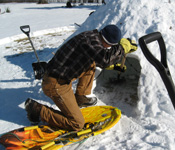 Winter camping is a unique, wonderful and challenging activity which combines warm weather camping skills with cold weather preparation and hopefully, lots of snow. The most important thing to prepare for is the temperature. To do this one must dress properly.
Winter camping is a unique, wonderful and challenging activity which combines warm weather camping skills with cold weather preparation and hopefully, lots of snow. The most important thing to prepare for is the temperature. To do this one must dress properly.
Dressing in layers is paramount. Each layer of clothing traps air which acts as insulation. The more layers you have, the more insulation. One danger is the build up of moisture(sweat) in the layer closest to your skin due to too high temperature and inability to evaporate sweat. You must act like a thermostat and regulate your temperature, by removing or opening your outer layer(s) as you become warm. If your inner layer inadvertently becomes wet, it must be replaced with a dry one. If you have perspired due to heavy exercise or hard travel; you must replace the wet under layers as soon as the activity is completed. Otherwise, the moisture will draw your body heat away from you and you will soon become cold. Therefor, bringing extra clothing, particularly under layers, is essential. Typical good under layers are made of polypropelyne or Merino wool. Outer layers should be the type that shed snow easily; most of the modern synthetics work well. Four layers of clothing is suggested. Boots must be insulated. The ones with the removable liners are best because the liners can be removed and dried or warmed around a fire or in your sleeping bag. Mitts are better than gloves, and again removable liners are best. Sometimes the liners can be worn alone when both are too warm. Head covering should be flexible and multi layered. Touques with ear flaps are great. As a rule, it is always best to overdress and later remove some layers to regulate body temperature rather than leave for camp with insufficient clothing.
For base camping or outings of short duration, I prefer sleeping in a snow shelter called a “quinzee” (spelled several ways) rather than hauling a heavy tent and portable wood stove. The quinzee provides good insulation and is similar to an igloo but is made by hollowing out a snow pile rather than stacking blocks of snow. The temperature inside the quinzee usually reaches a few degrees above zero. The finer details of construction will be given during the trip.
The traditional winter camping method is using a canvas tent with a woodstove. If the trip is of long duration and or distance, this method is preferred, as the wood stove can help dry wet clothing and boot liners and cook a meal. The wood stove must be loaded at least every 2 hours and night shifts should be assigned. For this equipment, and often firewood, a toboggan or sled must be pulled on the trip.
A good cold weather sleeping bag is essential, rated for AT LEAST -10 C. You can’t beat down, but any bag with an equivalent cold weather rating should do. This will be placed on top of an air filled sleeping pad like a Thermarest which will be placed on top of a foam pad and a tarp.
Travelling to the site can be by snow shoe or cross country ski. Skiis are a faster method of travel.
Add to this winter adventure, a great tasting hot meal and hot drinks, a starry sky and you have an unforgettable experience.
